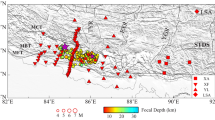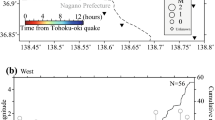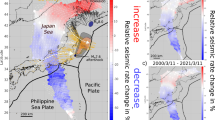Abstract
The nucleation and rupture processes of giant megathrust earthquakes (M ≥ 9.0) in subduction zones are still controversial. Most previous studies have focused on the subducting plate interface, and the structure beneath the subducting slab and its influence on earthquake generation remain unclear. Here, we present high-resolution seismic velocity tomography beneath six regions where giant earthquakes have occurred. Subslab low-velocity (slow) anomalies are revealed, which may reflect hot mantle upwelling. The giant earthquake hypocentres are generally located above the edges of the slow anomalies or above the gaps between them. Large coseismic slips of the giant earthquakes mainly occurred above gaps between the slow anomalies. We suggest that differential buoyancy force between the slow anomalies and their gaps may be an important factor for earthquake nucleation, and the rupture extent of a giant earthquake may be constrained by the slow anomalies. Hence, it is necessary to conduct seismic tomography to investigate the detailed subslab structure, which may help to pinpoint the potential location and damage zone of a future giant earthquake.
This is a preview of subscription content, access via your institution
Access options
Access Nature and 54 other Nature Portfolio journals
Get Nature+, our best-value online-access subscription
$29.99 / 30 days
cancel any time
Subscribe to this journal
Receive 12 print issues and online access
$259.00 per year
only $21.58 per issue
Buy this article
- Purchase on Springer Link
- Instant access to full article PDF
Prices may be subject to local taxes which are calculated during checkout



Similar content being viewed by others
Data availability
All data needed to evaluate the conclusions in the paper are provided in the paper and/or the Supplementary Information. All the 3D velocity models may be requested from the authors. The waveform data and P-wave arrival-time data were downloaded free from the Data Management Center of Hi-net and S-net (https://hinetwww11.bosai.go.jp/auth/download/cont/) and the ISC website (http://www.isc.ac.uk/isc-ehb/search/arrivals/).
Code availability
The free software GMT (https://www.generic-mapping-tools.org/) and AIMBAT56 were used in this study. The analysis codes and related scripts for generating figures used in the main text and Supplementary Information are available from the corresponding authors upon reasonable request.
References
Satake, K., Shimazaki, K., Tsuji, Y. & Ueda, K. Time and size of a giant earthquake in Cascadia inferred from Japanese tsunami records of January 1700. Nature 379, 246–249 (1996).
Wang, P. L. et al. Heterogeneous rupture in the great Cascadia earthquake of 1700 inferred from coastal subsidence estimates. J. Geophys. Res. Solid Earth 118, 2460–2473 (2013).
Johnson, J. M. & Satake, K. Asperity distribution of the 1952 great Kamchatka earthquake and its relation to future earthquake potential in Kamchatka. Pure Appl. Geophys. 154, 541–553 (1999).
Moreno, M., Bolte, J., Klotz, J. & Melnick, D. Impact of megathrust geometry on inversion of coseismic slip from geodetic data: application to the 1960 Chile earthquake. Geophys. Res. Lett. 36, L16310 (2009).
Ichinose, G., Somerville, P., Thio, H. K., Graves, R. & O’Connell, D. Rupture process of the 1964 Prince William Sound, Alaska, earthquake from the combined inversion of seismic, tsunami and geodetic data. J. Geophys. Res. 112, B07306 (2007).
Chlieh, M. et al. Coseismic slip and afterslip of the great Mw 9.15 Sumatra–Andaman earthquake of 2004. Bull. Seismol. Soc. Am. 97, S152–S173 (2007).
Iinuma, T. et al. Coseismic slip distribution of the 2011 off the Pacific Coast of Tohoku Earthquake (M9.0) refined by means of seafloor geodetic data. J. Geophys. Res. 117, B07409 (2012).
Scholz, C. H. & Campos, J. The seismic coupling of subduction zones revisited. J. Geophys. Res. 117, B05310 (2012).
Heuret, A., Conrad, C. P., Funiciello, F., Lallemand, S. & Sandri, L. Relation between subduction megathrust earthquakes, trench sediment thickness and upper plate strain. Geophys. Res. Lett. 39, L05304 (2012).
Song, T. R. A. & Simons, M. Trench-parallel gravity variations predict seismogenic behavior in subduction zones. Science 301, 630–633 (2003).
Schellart, W. P. & Rawlinson, N. Global correlations between maximum magnitudes of subduction zone interface thrust earthquakes and physical parameters of subduction zones. Phys. Earth Planet. Inter. 225, 41–67 (2013).
Nishikawa, T. & Ide, S. Earthquake size distribution in subduction zones linked to slab buoyancy. Nat. Geosci. 7, 904–908 (2014).
Gao, X. & Wang, K. Strength of stick-slip and creeping subduction megathrusts from heat flow observations. Science 345, 1038–1041 (2014).
Bletery, Q. et al. Mega-earthquakes rupture flat megathrusts. Science 354, 1027–1031 (2016).
Liu, X. & Zhao, D. Upper and lower plate controls on the great 2011 Tohoku-oki earthquake. Sci. Adv. 4, eaat4396 (2018).
Bodmer, M., Toomey, D. R., Hooft, E. E. E. & Schmandt, B. Buoyant asthenosphere beneath Cascadia influences megathrust segmentation. Geophys. Res. Lett. 45, 6954–6962 (2018).
Bodmer, M., Toomey, D. R., Roering, J. J. & Karlstrom, L. Asthenospheric buoyancy and the origin of high-relief topography along the Cascadia forearc. Earth Planet. Sci. Lett. 531, 115965 (2020).
Chen, C., Zhao, D. & Wu, S. Tomographic imaging of the Cascadia subduction zone: constraints on the Juan de Fuca slab. Tectonophysics 647-648, 73–88 (2015).
Hawley, W. B., Allen, R. M. & Richards, M. A. Tomography reveals buoyant asthenosphere accumulating beneath the Juan de Fuca plate. Science 353, 1406–1408 (2016).
Liu, X. & Zhao, D. P and S wave tomography of Japan subduction zone from joint inversions of local and teleseismic travel times and surface-wave data. Phys. Earth Planet. Inter. 252, 1–22 (2016).
Portner, D. E., Beck, S., Zandt, G. & Scire, A. The nature of subslab slow velocity anomalies beneath South America. Geophys. Res. Lett. 44, 4747–4755 (2017).
Pesicek, J., Engdahl, E., Thurber, C., DeShon, H. & Lange, D. Mantle subducting slab structure in the region of the 2010 M8.8 Maule earthquake (30–40° S), Chile. Geophys. J. Int. 191, 317–324 (2012).
Huang, Z., Zhao, D. & Wang, L. P wave tomography and anisotropy beneath Southeast Asia: insight into mantle dynamics. J. Geophys. Res. Solid Earth 120, 5154–5174 (2015).
Wirth, E. A. & Frankel, A. D. Impact of down-dip rupture limit and high-stress drop subevents on coseismic land-level change during Cascadia megathrust earthquakes. Bull. Seismol. Soc. Am. 109, 2187–2197 (2019).
Griffin, J., Nguyen, N., Cummins, P. & Cipta, A. Historical earthquakes of the eastern Sunda Arc: source mechanisms and intensity-based testing of Indonesia’s national seismic hazard assessment. Bull. Seismol. Soc. Am. 109, 43–65 (2019).
Zhao, D., Yanada, T., Hasegawa, A., Umino, N. & Wei, W. Imaging the subducting slabs and mantle upwelling under the Japan Islands. Geophys. J. Int. 190, 816–828 (2012).
Gorbatov, A., Fukao, Y., Widiyantoro, S. & Gordeev, E. Seismic evidence for a mantle plume oceanwards of the Kamchatka–Aleutian trench junction. Geophys. J. Int. 146, 282–288 (2001).
Honda, S., Morishige, M. & Orihashi, Y. Sinking hot anomaly trapped at the 410-km discontinuity near the Honshu subduction zone, Japan. Earth Planet. Sci. Lett. 261, 565–577 (2007).
Morgan, J. P., Hasenclever, J. & Shi, C. New observational and experimental evidence for a plume-fed asthenosphere boundary layer in mantle convection. Earth Planet. Sci. Lett. 366, 99–111 (2013).
Zhao, D. Seismic images under 60 hotspots: search for mantle plumes. Gondwana Res. 12, 335–355 (2007).
Hicks, S. P., Nippress, S. E. J. & Rietbrock, A. Sub-slab mantle anisotropy beneath south-central Chile. Earth Planet. Sci. Lett. 357–358, 203–213 (2012).
Long, M. D. & Silver, P. G. The subduction zone flow field from seismic anisotropy: a global view. Science 319, 315–318 (2008).
Bezada, M. J., Faccenda, M. & Toomey, D. R. Representing anisotropic subduction zones with isotropic velocity models: a characterization of the problem and some steps on a possible path forward. Geochem. Geophys. Geosyst. 17, 3164–3189 (2016).
Liu, X. & Zhao, D. Seismic velocity azimuthal anisotropy of the Japan subduction zone: constraints from P and S wave traveltimes. J. Geophys. Res. Solid Earth 121, 5086–5115 (2016).
Gou, T., Zhao, D., Huang, Z. & Wang, L. Aseismic deep slab and mantle flow beneath Alaska: insight from anisotropic tomography. J. Geophys. Res. Solid Earth 124, 1700–1724 (2019).
Hall, R. & Spakman, W. Mantle structure and tectonic history of SE Asia. Tectonophysics 658, 14–45 (2015).
Rosenbaum, G. & Mo, W. Tectonic and magmatic responses to the subduction of high bathymetric relief. Gondwana Res. 19, 571–582 (2011).
Lee, S. J., Huang, B. S., Ando, M., Chiu, H. C. & Wang, J. H. Evidence of large scale repeating slip during the 2011 Tohoku-oki earthquake. Geophys. Res. Lett. 38, L19306 (2011).
Zhang, N., Dang, Z., Huang, C. & Li, Z. X. The dominant driving force for supercontinent breakup: plume push or subduction retreat? Geosci. Front. 9, 997–1007 (2018).
Scholz, C. H. On the stress dependence of the earthquake b value. Geophys. Res. Lett. 42, 1399–1402 (2015).
Müller, R. D., Sdrolias, M., Gaina, C. & Roest, W. R. Age, spreading rates and spreading asymmetry of the world’s ocean crust. Geochem. Geophys. Geosyst. 9, Q04006 (2008).
Bürgmann, R. et al. Interseismic coupling and asperity distribution along the Kamchatka subduction zone. J. Geophys. Res. 110, B07405 (2005).
Chlieh, M., Avouac, J. P., Sieh, K., Natawidjaja, D. H. & Galetzka, J. Heterogeneous coupling of the Sumatran megathrust constrained by geodetic and paleogeodetic measurements. J. Geophys. Res. 113, B05305 (2008).
Gou, T., Zhao, D., Huang, Z. & Wang, L. Structural heterogeneity in source zones of the 2018 Anchorage intraslab earthquake and the 1964 Alaska megathrust earthquake. Geochem. Geophys. Geosyst. 21, e2019GC008812 (2020).
Nishikawa, T. et al. The slow earthquake spectrum in the Japan Trench illuminated by the S-net seafloor observatories. Science 365, 808–813 (2019).
Chuang, L., Bostock, M., Wech, A. & Plourde, A. Plateau subduction, intraslab seismicity and the Denali (Alaska) volcanic gap. Geology 45, 647–650 (2017).
Kato, N. Interaction of slip on asperities: numerical simulation of seismic cycles on a two-dimensional planar fault with nonuniform frictional property. J. Geophys. Res. 109, B12306 (2004).
Zhao, D. Multiscale Seismic Tomography (Springer, 2015).
Engdahl, E. R., van der Hilst, R. & Buland, R. Global teleseismic earthquake relocation with improved travel times and procedures for depth determination. Bull. Seismol. Soc. Am. 88, 722–743 (1998).
Weston, J., Engdahl, E. R., Harris, J., Di Giacomo, D. & Storchack, D. A. ISC-EHB: reconstruction of a robust earthquake dataset. Geophys. J. Int. 214, 474–484 (2018).
Okada, Y. et al. Recent progress of seismic observation networks in Japan –Hi-net, F-net, K-NET and KiK-net–. Earth Planets Space 56, xv–xxviii (2004).
Uehira, K. et al. S-net project: construction of large-scale seismic and tsunami observation system on seafloor along the Japan Trench. Geophys. Res. Abstr. 20, EGU2018–12000 (2018).
Zhao, D., Yamamoto, Y. & Yanada, T. Global mantle heterogeneity and its influence on teleseismic regional tomography. Gondwana Res. 23, 595–616 (2013).
Zhao, D., Hasegawa, A. & Kanamori, H. Deep structure of Japan subduction zone as derived from local, regional and teleseismic events. J. Geophys. Res. 99, 22313–22329 (1994).
Fan, J. & Zhao, D. P-wave anisotropic tomography of the central and southern Philippines. Phys. Earth Planet. Inter. 286, 154–164 (2019).
Lou, X., van der Lee, S. & Lloyd, S. AIMBAT: a Python/Matplotlib tool for measuring teleseismic arrival times. Seismol. Res. Lett. 84, 85–93 (2013).
VanDecar, J. C. & Crosson, R. S. Determination of teleseismic relative phase arrival times using multi-channel cross-correlation and least squares. Bull. Seismol. Soc. Am. 80, 150–169 (1990).
Kennett, B. L. N. & Engdahl, E. R. Traveltimes for global earthquake location and phase identification. Geophys. J. Int. 105, 429–465 (1991).
Laske, G., Masters, G., Ma, Z. & Pasyanos, M. Update on CRUST1.0—a 1-degree global model of Earth’s crust. Geophys. Res. Abstr. 15, 2013–2658 (2013).
Acknowledgements
We thank the data centres of the Japanese seismic networks and the JMA Unified Earthquake Catalog for providing the high-quality waveform and arrival-time data used for the study of the Japan subduction zone. P.-L. Wang kindly provided her Cascadia slip model. T. Gou provided his Alaska tomographic model. This work was financially supported by the Strategic Priority Research Program of the Chinese Academy of Sciences (XDB42000000) and the National Natural Science Foundation of China (grant no. 41876043, to J.F.) and the Japan Society for the Promotion of Science (grant no. 19H01996, to D.Z.).
Author information
Authors and Affiliations
Contributions
J.F. and D.Z. conceived this study. J.F. conducted data processing and tomographic inversions. Both authors contributed to the interpretations and preparation of the manuscript.
Corresponding authors
Ethics declarations
Competing interests
The authors declare no competing interests.
Additional information
Peer review information Nature Geoscience thanks the, anonymous, reviewer(s) for their contribution to the peer review of this work. Primary Handling Editor: Stefan Lachowycz.
Publisher’s note Springer Nature remains neutral with regard to jurisdictional claims in published maps and institutional affiliations.
Supplementary information
Supplementary Information
Supplementary Figs. 1–35.
Rights and permissions
About this article
Cite this article
Fan, J., Zhao, D. Subslab heterogeneity and giant megathrust earthquakes. Nat. Geosci. 14, 349–353 (2021). https://doi.org/10.1038/s41561-021-00728-x
Received:
Accepted:
Published:
Issue Date:
DOI: https://doi.org/10.1038/s41561-021-00728-x
This article is cited by
-
Seismic Anisotropy Tomography and Mantle Dynamics
Surveys in Geophysics (2023)



